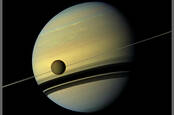This article is more than 1 year old
We'll explore Titan with a methane submarine, a methane submarine, a methane submarine...
Saturn moon's largest liquid sea mapped by radar – and soon, robots?
Titan’s largest sea of liquid is estimated to be over 1,000 feet deep, judging from new radar analysis, making it an ideal location for a future autonomous robotic submarine to explore.
Saturn's moon Titan, and our home world Earth, are the only two bodies in the Solar System known to have stable liquid on their surfaces. Titan's largest sea, Kraken Mare, is now believed to be 1,000ft+ in depth according to a study published in the Journal of Geophysical Research. That sea is composed of 70 per cent methane, 16 per cent nitrogen, and 14 per cent ethane. Bear in mind the temperature on Titan is roughly -179.6°C (-292°F, 93.6K).
“The depth and composition of each of Titan’s seas had already been measured, except for Titan’s largest sea, Kraken Mare – which not only has a great name, but also contains about 80 per cent of the moon’s surface liquids,” said Valerio Poggiali, lead author of the paper and a research associate at Cornell University’s Center for Astrophysics and Planetary Science.

Saturn's largest satellite, Titan, is drifting away from its planet 100 times faster than previously thought
READ MOREOther seas and lakes are deep enough for future submarines to explore, though Kraken Mare will be the easiest target because of its size, he added. Poggiali reckons spacecraft could land and deploy a submersible easily, and strong currents and tides could help the vehicle navigate underwater. The vehicle would probably carry a camera, sonar, mass spectrometer, and a meteorology package to measure wind, temperature, and humidity conditions.
How it was found
NASA's Cassini-Huygens probe detected a number of large dark patches at Titan's poles. Images beamed back to Earth showed what appeared to be shorelines, and radar data later confirmed that those patches were indeed pools of liquid. The three largest bodies were named: Kraken Mare, Ligeia Mare, and Punga Mare.
Although scientists have known about Titan’s largest sea – named after the Kraken, a mythical gigantic octopus-like creature with long tentacles that can take down ships – since 2008, no one has measured its properties until now. Poggiali and his colleagues sifted through data obtained from Cassini’s radar altimeter to come up with new estimates of the depths of Kraken Mare. Direct measurements are impossible.
Scientists typically measure depth in these sorts of cases by sending a radio beam, waiting for its reflected signal to arrive, and calculating the distance from the round-trip time. When Cassini directed its radar altimeter onto Kraken Mare, however, nothing came back. It is either too deep, or its liquid absorbs the incoming radar waves.
So instead, the team deduced the depth by analyzing a shallower portion of the sea. They found that the Moray Sinus, the northern area of Kraken Mare that meets an estuary, is about 85 metres deep. From that they extrapolated the readings, using a variety of data models, to estimate the sea's deepest section.
“While in the best-case scenario the Cassini radar could have probed the seafloor up to 1,000 feet, in the worst-case it would have been able to distinguish seafloor echoes of 330 feet or shallower,” Poggiali told The Register on Thursday.
“Thus, the central part of Kraken Mare must be deeper than 330 feet and likely more than 1,000 feet. Our conclusion is also based on lake size and depth correlations on Earth, which were consistent with the depth measured at the second largest sea – Ligeia Mare – that we could measure the depth of.”
While NASA has done some preliminary work on designing a submarine capable of navigating the methane seas of Titan, it's going to try searching above sea level first. The delayed Dragonfly drone, due for launch in 2027, will enter Titan's atmosphere, and test the chemistry and environment of the moon for signs of the building blocks of life, and survey the surface. ®
